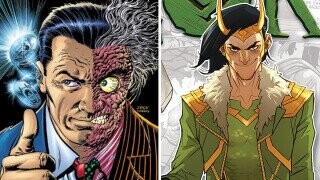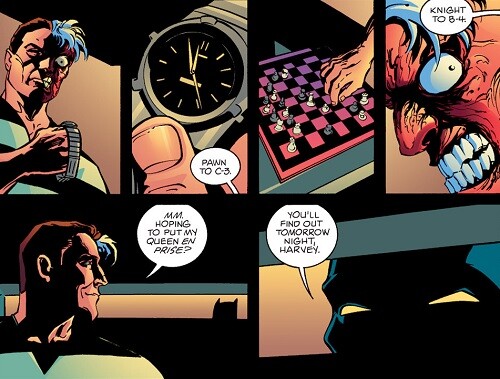From Two-Face To Loki: The Appeal Of 'Frenemy' Supervillains

The least surprising plot twist in superhero adaptations is when they introduce a good guy with a name like "Victor Von Doom" or "Obadiah Stane" or "Baron Mordo" or anything that might sound like a '60s comic book villain and then *gasp* he turns into a villain. The Green Lantern movie seriously sprung a pencil-mustached dude called "Sinestro" on audiences and expected them to be surprised when he did something sinister. It's silly, but there's a good reason why they keep doing that: villains who used to be buddies with the hero tend to be way more interesting and rife with dramatic potential.
The archetypal example is Two-Face, who went from just another themed crime boss to a tragic and compelling figure when Batman: Year One and Batman: The Animated Series established that he was once Bruce Wayne's pal. Sure, Batman still punches him a whole lot, but now those punches are tinted with sadness and regret. According to the comics, they still have a game of chess going, despite being mortal enemies.

DC Comics
Don't Miss
Speaking of chess enthusiasts, another famous example is the long-running hatebromance between Magneto and Professor X. As we've discussed, Magneto was a pretty stereotypical comic book baddie until writer Christ Claremont gave him a more sympathetic backstory as a Holocaust survivor -- which included the revelation that he and a young "Chuckles" Xavier once kicked some Nazi ass together. This was once a pretty small plot point, but by now, it's hard to conceive of one character without the other. Pics below unrelated.
Loki is another character whose appeal and cultural relevance have exploded since Marvel started playing up the fact that he's known Thor since he was in diapers. For a long time, the family connection was only a footnote, and even when Loki was forced to fight on his adopted bro's side, he always made it clear it was out of pure self-interest.

Marvel Comics
But then, right before the first Thor movie, Marvel writers started playing with the idea that Thor and Loki do give a crap about each other, in their own way. This angle led to multiple solo series exploring the possibility or impossibility of Loki's redemption. These, or the Disney+ Loki show, would have been unthinkable (or at least pretty boring) with the purely evil pre-2010 Loki.
The oldest instance of this phenomenon is probably the time Lex Luthor was revealed to be a childhood friend of Superboy who turned evil because he blames the Boy of Steel for his premature baldness. It's an extremely corny origin, and one that's probably best left in the Silver Age, but it did serve as the first attempt to flesh out the character beyond "he's a bald guy who wants to rule the planet and finds prison jumpsuits quite comfy."
Sinestro, Doctor Doom (or "Uncle Doom" to Mr. Fantastic's second kid), and Flash's entire Rogues Gallery are more villains who have gained new dimensions since the writers deepened their connections to the heroes in some way or another. Human relationships are usually more complicated than "this person is evil and I hate them" and it's good that more superhero stories have started reflecting that. Of course, revealing a shared past isn't the only way to do this, but when used within the limits of logic and common sense, it can be a pretty effective narrative tool. Anyway, Marvel, please buy our pitch about a comic where Nick Fury and Thanos find out they went to preschool together.
Follow Maxwell Yezpitelok's heroic effort to read and comment on every '90s Superman comic at Superman86to99.tumblr.com.
Top image: Marvel Comics, DC Comics